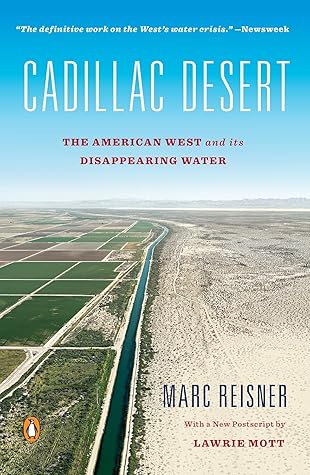More on this book
Community
Kindle Notes & Highlights
by
Marc Reisner
Read between
December 5, 2019 - February 2, 2020
The whole state thrives, even survives, by moving water from where it is, and presumably isn’t needed, to where it isn’t, and presumably is needed. No other state has done as much to fructify its deserts, make over its flora and fauna, and rearrange the hydrology God gave it. No other place has put as many people where they probably have no business being. There is no place like it anywhere on earth. Thirty-one million people (more than the population of Canada), an economy richer than all but seven nations’ in the world, one third of the table food grown in the United States—and none of it
...more
Edmonston’s scheme was mesmerizing. The largest water project ever built by a state or local government was New York City’s Delaware water system, completed during World War II. The Delaware Aqueduct was eighty-five miles long and entirely underground—by far the longest hard-rock tunnel in the world. But the California Water Plan, in its first phase alone, contemplated the movement of four times more water over a distance six times as long. What was even more startling was that most of the water would go to irrigation. The Delaware Aqueduct had left New York, a Babylon of wealth, up to its
...more
What passed for an answer provides an insight into the thinking of Edmonston and the water lobby and a good many politicians at the time. It was also as remarkable a statement as any certifiably sane person ever made. “It is believed that the cost of water will not be a limiting factor in ultimate development of the water resources of California,” Edmonston’s report read. “It is indicated that urban communities will always be able and willing to pay the cost of water to meet their municipal needs. Furthermore, it is considered probable that under pressure of future demands for agricultural
...more
If anyone found such a statement preposterous—it was really like saying that, because of population pressure, we were bound to settle Mars—he kept his opinions to himself. The nearest thing to a publicly expressed doubt was the somewhat timorous suggestion of the Stanford Research Institute, which was asked to comment on the report, that a “definite price policy” would be required for “more realistic estimates of probable water sales,” and that these, in turn, might well decide “the financial outcome of the project”—that is, whether or not it would end in the greatest bankruptcy of all time.
...more
This highlight has been truncated due to consecutive passage length restrictions.
Brown knew that a lot of voters will vote reflexively against any bond issue, even one to hire police and build jails in the midst of a crime wave. They would rather not pay taxes and buy guns, rather not pay taxes and dig wells. This was especially true in southern California, the home turf of the John Birch Society and the Liberty Lobby. Northern Californians were sure to be violently opposed, even if they were promised some of the water. Northern Californians had always resisted sending their water to Los Angeles. Between metropolitan San Francisco, Sacramento, San Jose, Oakland, Stockton,
...more


